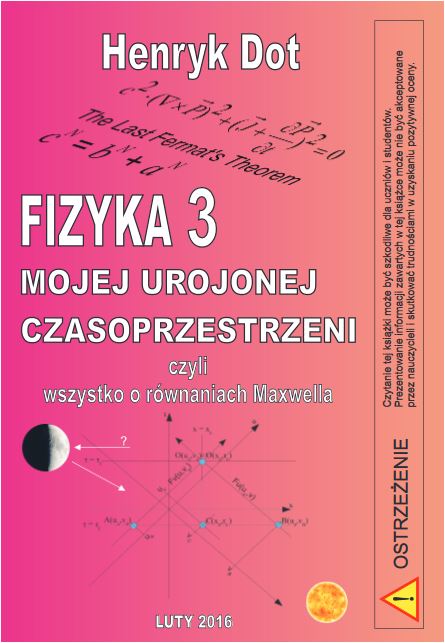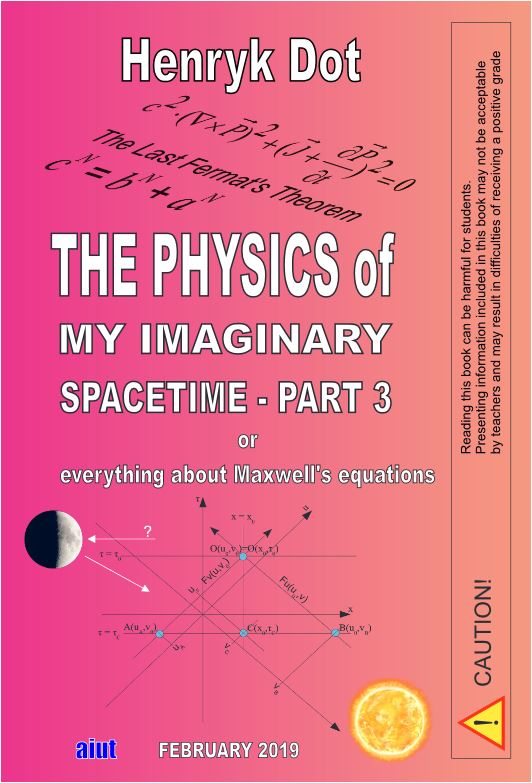★ HenrykDot.com
★
is the online companion to a series of books published by AIUT under the common main title
"Physics of My Imaginary Space-Time" by Henryk Dot.
is the online companion to a series of books published by AIUT under the common main title
"Physics of My Imaginary Space-Time" by Henryk Dot.
Home
Physics 3 - Maxwell
Note from the Author
Table of Contents
What is this book
Historical facts
New aspects
Fully erroneous
Incorrectly interpreted
Physics 3 - Chapter 1
Equations
Complex vectors form
The Most General form
The General Solution
Physics 3 - Chapter 2
Solutions
Initial conditions
Non-homogeneous equation
Solution for three-directions
The four laws
Physics 3 - Supplement
Fermat's proof
Beal's conjecture
Pythagorean triples
Inertial mass
Gravity constans big G
What does the Moon look at?
Physics 3 - Final notes
Final notes
Physics 4 - New book
Entry
Physics 3 - Maxwell
Note from the Author
Table of Contents
What is this book
Historical facts
New aspects
Fully erroneous
Incorrectly interpreted
Physics 3 - Chapter 1
Equations
Complex vectors form
The Most General form
The General Solution
Physics 3 - Chapter 2
Solutions
Initial conditions
Non-homogeneous equation
Solution for three-directions
The four laws
Physics 3 - Supplement
Fermat's proof
Beal's conjecture
Pythagorean triples
Inertial mass
Gravity constans big G
What does the Moon look at?
Physics 3 - Final notes
Final notes
Physics 4 - New book
Entry
Contact
email: henryk.dot(at)aiut.com
"Subject" should begin with
a digit corresponding to the day
of the week., e.g. Sunday=7
"Subject" should begin with
a digit corresponding to the day
of the week., e.g. Sunday=7
Books published by AIUT
are found in libraries according to the list of compulsory copies.
Second Edition of "Fizyka 3"
ISBN 978-83-926856-1-6

can be bought in Warsaw
in the Academic Bookstore
PW Publishing House
Noakowskiego street 18/20
and in Katowice
in the bookstore "Liber"
Bankowa street 11.
(area of Silesian University)
English edition of "Physics"
ISBN 978-83-926856-2-3

is also in libraries
and the distribution method should be asked wydawca@aiut.com.
|
| ||
|
2.3.3. Correct interpretation of inverse square law The specific feature of solutions presented in this book is to show that inverse square (distance) relation is independent of any requirements of limitations. The examples of such imposed requirements are for instance: field around charge in Gauss’ theorem should be uniform (identical in all directions) or that laws are applicable to whole area except the point where R=0. Such limitations were already pointed out in paragraph I.5 – “Incorrectly interpreted specific problems”. We are searching then for solutions which do not depend on limitations listed above. By changing the order of integration in equation (2.93), | ||
|
|
(2.95) | |
|
we can change the integration by spherical angle Ω to integration
on whole surface of a sphere having specific radius = R. Elementary spherical angle dΩ can be treated as a product of two elementary angles | ||
|
|
(2.96) | |
|
(where da and db
represent elementary sections located at vertical and horizontal circles
with radius R, ). Formula (2.95) then takes a form of: | ||

|
(2.97) | |
|
Sections of circles da and db and radius R are depicted on the drawing (Fig. 4).
The arcs a and b shown on vertical and horizontal circles represent
the angles α = a/R and β = b/R respectively, showing the projection of the vector R onto the XY plane and the position of the vector R relative to the XY plane - and determine accordingly: w x = cos( b/R) · cos( a/R), w y = sin( b/R) · cos( a/R) and w z = sin( a/R). | ||
|
x
a
da
R
|
